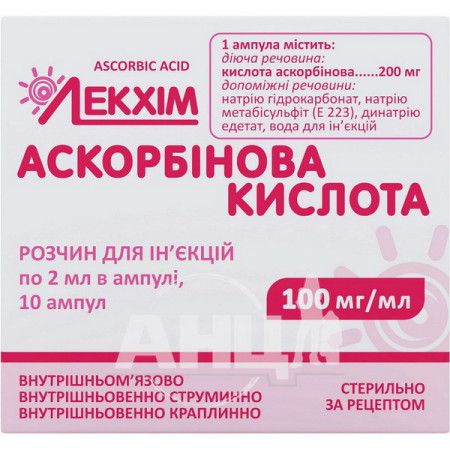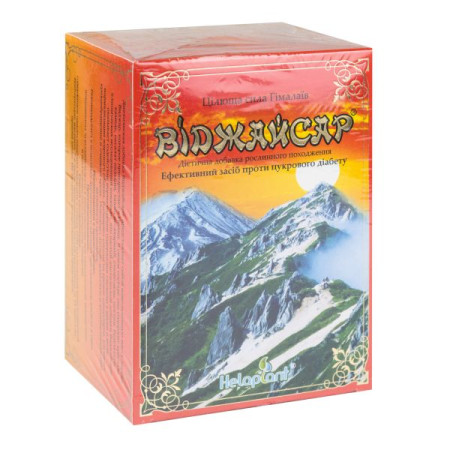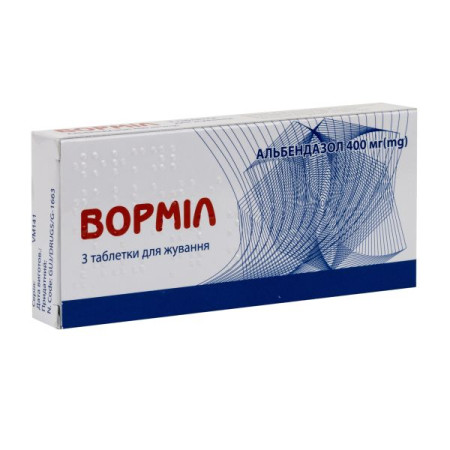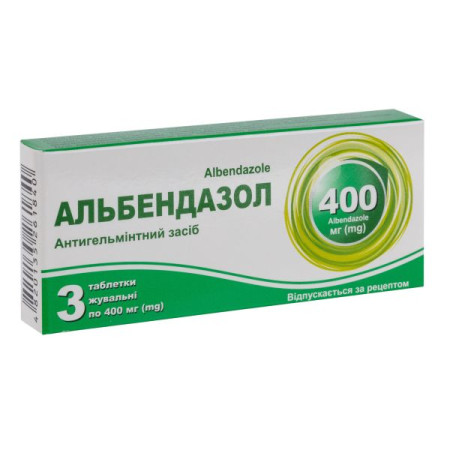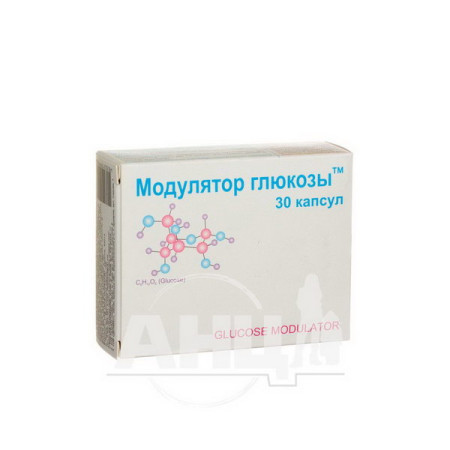Nerviplex-N solution for injection ampoule 2 ml No. 5
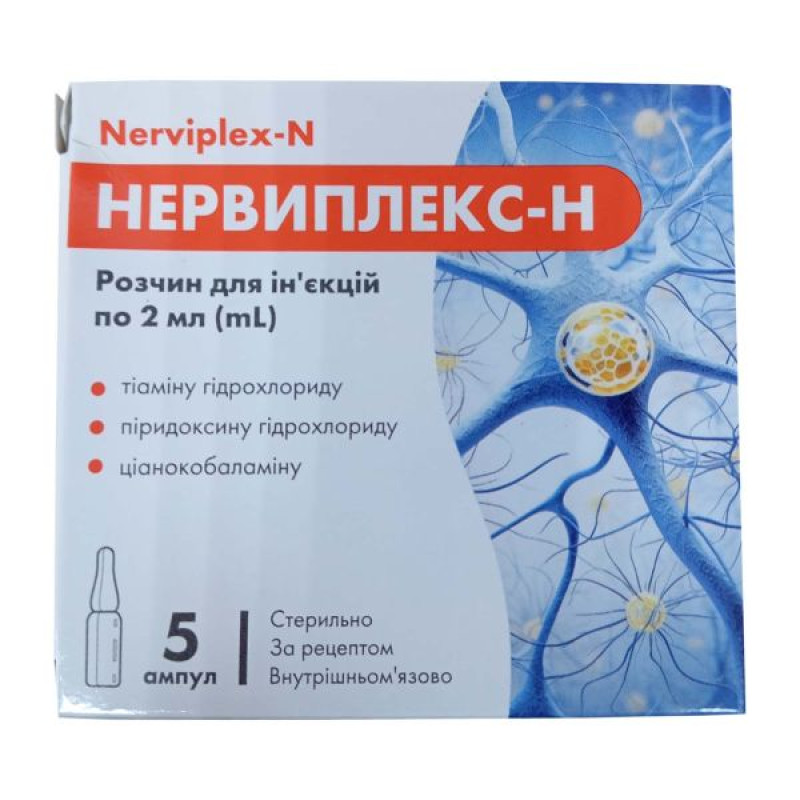
Instructions Nerviplex-N solution for injection ampoule 2 ml No. 5
Composition
active ingredients: thiamine hydrochloride, pyridoxine hydrochloride, cyanocobalamin;
1 ml of solution contains thiamine hydrochloride (calculated as 100% substance) 50 mg, pyridoxine hydrochloride (calculated as 100% substance) 50 mg, cyanocobalamin (calculated as 100% substance) 0.5 mg;
Excipients: lidocaine hydrochloride, benzyl alcohol, sodium polyphosphate, potassium ferricyanide, sodium hydroxide, water for injection.
Dosage form
Solution for injection.
Main physicochemical properties: transparent red liquid.
Pharmacotherapeutic group
Vitamin B1 preparations in combination with vitamin B6 and/or vitamin B12. ATX code A11D B.
Pharmacological properties
Pharmacodynamics
Neurotropic B vitamins have a beneficial effect on inflammatory and degenerative diseases of the nerves and musculoskeletal system. They are used to eliminate deficiency states, and in large doses they have analgesic properties, improve blood circulation, normalize the functioning of the nervous system and the process of hematopoiesis.
Vitamin B1 is a very important active substance. In the body, vitamin B1 is phosphorylated to form biologically active thiamine diphosphate (cocarboxylase) and thiamine triphosphate (TTP).
Thiamine diphosphate as a coenzyme participates in important functions of carbohydrate metabolism, which are of crucial importance in the metabolic processes of nervous tissue, affecting the conduction of nerve impulses in synapses. With a deficiency of vitamin B1 in tissues, metabolites accumulate, primarily lactic and pyruvic acid, which leads to various pathological conditions and disorders of the nervous system.
Vitamin B6 in its phosphorylated form (pyridoxal-5'-phosphate, PALP) is a coenzyme for a number of enzymes that interact in the general non-oxidative metabolism of amino acids. Through decarboxylation, they are involved in the formation of physiologically active amines (adrenaline, histamine, serotonin, dopamine, tyramine), through transamination - in anabolic and catabolic metabolic processes (for example, glutamate-oxaloacetate transaminase, glutamatepyruvate transaminase, γ-aminobutyric acid, α-ketoglutarate transaminase), as well as in various processes of amino acid breakdown and synthesis. Vitamin B6 acts at 4 different sites of tryptophan metabolism. Within the framework of hemoglobin synthesis, vitamin B6 catalyzes the formation of α-amino-β-ketoadenic acid.
Vitamin B12 is necessary for cellular metabolism. It affects the function of hematopoiesis (extrinsic anti-anemic factor), participates in the formation of choline, methionine, creatinine, nucleic acids, and has an analgesic effect.
Pharmacokinetics
After parenteral administration, thiamine is distributed in the body. Approximately 1 mg of thiamine is broken down daily. Metabolites are excreted in the urine. Dephosphorylation occurs in the kidneys. The biological half-life of thiamine is 21 minutes. Thiamine does not accumulate in the body due to its limited solubility in fats.
Vitamin B6 is phosphorylated and oxidized to pyridoxal-5-phosphate. In blood plasma, pyridoxal-5-phosphate and pyridoxal are bound to albumin. The form that is transported is pyridoxal. To pass through the cell membrane, pyridoxal-5-phosphate bound to albumin is hydrolyzed by alkaline phosphatase to pyridoxal.
Vitamin B12 after parenteral administration forms transport protein complexes that are rapidly absorbed by the liver, bone marrow and other proliferative organs. Vitamin B12 enters the bile and participates in the enterohepatic circulation. Vitamin B12 crosses the placenta.
Indication
Neurological diseases of various origins: neuritis, neuralgia, polyneuropathies (diabetic, alcoholic), radicular syndrome, retrobulbar neuritis, facial nerve damage.
Contraindication
Hypersensitivity to the components of the drug; acute cardiac conduction disorders; acute form of decompensated heart failure.
Vitamin B1 is contraindicated in allergic reactions.
Vitamin B6 is contraindicated for use in cases of gastric and duodenal ulcers in the acute stage (since increased acidity of gastric juice is possible).
Vitamin B12 is contraindicated for use in erythremia, erythrocytosis, thromboembolism, and psoriasis.
Lidocaine. Increased individual sensitivity to lidocaine or other amide local anesthetics, history of epileptiform seizures to lidocaine, severe bradycardia, severe arterial hypotension, cardiogenic shock, severe forms of chronic heart failure (grade II-III), sick sinus syndrome, Wolff-Parkinson-White syndrome, Adams-Stokes syndrome, atrioventricular (AV) block of the II and III degree, hypovolemia, severe liver/kidney dysfunction, porphyria, myasthenia gravis.
Do not use the drug during pregnancy and/or breastfeeding.
Interaction with other medicinal products and other types of interactions
The action of thiamine is inactivated by 5-fluorouracil, as the latter competitively inhibits the phosphorylation of thiamine to thiamine pyrophosphate. Loop diuretics, such as furosemide, which inhibit tubular reabsorption, may cause increased thiamine excretion during long-term therapy and thus reduce thiamine levels.
Concomitant use with levodopa is contraindicated, as vitamin B6 may reduce the antiparkinsonian effect of levodopa in the absence of peripheral dopa decarboxylase inhibitors. Concomitant use with pyridoxine antagonists (e.g. isoniazid, hydralazine, penicillamine or cycloserine), oral contraceptives may increase the need for vitamin B6.
Consumption of beverages containing sulfites (e.g. wine) increases the degradation of thiamine.
Lidocaine enhances the depressant effect on the respiratory center of anesthetics (hexobarbital, thiopental sodium intravenously), hypnotics and sedatives; weakens the cardiotonic effect of digitoxin. With simultaneous use with hypnotics and sedatives, an increase in the depressant effect on the central nervous system is possible. Ethanol enhances the depressant effect of lidocaine on respiratory function.
Beta-blockers (including propranolol, nadolol) - slow down the metabolism of lidocaine in the liver, enhance the effects of lidocaine (including toxic ones) and increase the risk of developing bradycardia and hypotension.
Curare-like drugs - possible deepening of myorelaxation (up to paralysis of the respiratory muscles).
Norepinephrine, mexiletine – increases the toxicity of lidocaine (decreases the clearance of lidocaine).
Isadrin and glucagon - increase the clearance of lidocaine.
Cimetidine, midazolam - increases the concentration of lidocaine in plasma. Cimetidine displaces it from protein binding and slows down the inactivation of lidocaine in the liver, which increases the risk of increased side effects of lidocaine. Midazolam moderately increases the concentration of lidocaine in the blood.
Anticonvulsants, barbiturates (including phenobarbital) - possible acceleration of lidocaine metabolism in the liver, decrease in blood concentration.
Antiarrhythmics (amiodarone, verapamil, quinidine, ajmalin, disopyramide), anticonvulsants (hydantoin derivatives) - cardiodepressive effect is enhanced; simultaneous use with amiodarone may lead to the development of seizures.
Novocaine, novocainamide – when used in combination with lidocaine, central nervous system excitation and hallucinations are possible.
Monoamine oxidase inhibitors, aminazine, bupivacaine, amitriptyline, nortriptyline, imipramine - when used in combination with lidocaine, the risk of developing arterial hypotension increases and the local anesthetic effect of the latter is prolonged.
Narcotic analgesics (morphine, etc.) – when used in combination with lidocaine, the analgesic effect of narcotic analgesics is enhanced, but respiratory depression is also increased.
Prenylamine – increases the risk of developing torsades de pointes.
Propafenone – possible increase in the duration and severity of side effects from the central nervous system.
Rifampicin – may decrease the concentration of lidocaine in the blood.
Polymyxin B – respiratory function should be monitored.
Procainamide – possible hallucinations.
Cardiac glycosides – when used in combination with lidocaine, the cardiotonic effect of cardiac glycosides is weakened.
Digitalis glycosides – against the background of lidocaine intoxication, it can increase the severity of AV block.
Vasoconstrictors (epinephrine, methoxamine, phenylephrine) - when used in combination with lidocaine, they help slow the absorption of lidocaine and prolong the effect of the latter.
Guanadrel, guanethidine, mecamylamine, trimetaphan – when used in combination for spinal and epidural anesthesia, the risk of severe hypotension and bradycardia increases.
β-blockers - when used in combination, they slow down the metabolism of lidocaine in the liver, enhance the effects of lidocaine (including toxic ones) and increase the risk of developing bradycardia and arterial hypotension. When using β-blockers and lidocaine simultaneously, it is necessary to reduce the dose of the latter.
Acetazolamide, thiazide and loop diuretics – when used in combination with lidocaine, as a result of creating hypokalemia, reduce the effect of the latter.
Anticoagulants (including ardeparin, dalteparin, danaparoid, enoxaparin, heparin, warfarin, etc.) - when used in combination with lidocaine, they increase the risk of bleeding.
Anticonvulsants, barbiturates (phenytoin) - when used in combination with lidocaine, it is possible to accelerate the metabolism of lidocaine in the liver, reduce its concentration in the blood, and increase the cardiodepressive effect.
Drugs that cause blockade of neuromuscular transmission - when used in combination with lidocaine, the effect of drugs that cause blockade of neuromuscular transmission is enhanced, since the latter reduce the conductivity of nerve impulses.
Application features
The drug should not be administered intravenously.
Long-term use of vitamin B6 (over 6-12 months) in doses exceeding 50 mg daily or in doses exceeding 1000 mg daily (over 2 months) may lead to reversible peripheral sensory neuropathy. If symptoms of peripheral sensory neuropathy (paresthesia) occur, the dose of the drug should be adjusted and, if necessary, treatment should be discontinued.
The drug contains sodium compounds. This should be taken into account by patients on a salt-free diet. Each ampoule may contain traces of potassium.
Since the drug contains vitamin B6, the drug should be used with caution in patients with a history of peptic ulcer of the stomach and duodenum, with severe renal and hepatic dysfunction.
Patients with neoplasms, except for cases accompanied by megaloblastic anemia and vitamin B12 deficiency, should not use the drug.
The drug is not used in severe forms of cardiac decompensation and angina pectoris.
Since the drug contains lidocaine, it should be noted that when treating the injection site with disinfectant solutions containing heavy metals, the risk of developing a local reaction in the form of soreness and swelling increases.
Since lidocaine has a pronounced antiarrhythmic effect and can itself act as an arrhythmogenic factor, which can cause the development of arrhythmia, the drug should be used with caution in individuals with complaints of arrhythmia in the past.
Use with caution in patients with moderate heart failure, moderate arterial hypotension, incomplete AV block, intraventricular conduction disorders, moderate liver and kidney dysfunction (creatinine clearance 10 ml/min), respiratory function disorders, epilepsy, after heart surgery, with a genetic predisposition to hyperthermia, debilitated patients and elderly patients.
ECG monitoring is mandatory during the use of lidocaine. In case of sinus node dysfunction, prolongation of the PQ interval, QRS widening, or the development of a new arrhythmia, the dose should be reduced or the drug should be discontinued.
Before using lidocaine for heart disease (hypokalemia reduces the effectiveness of lidocaine), it is necessary to normalize the level of potassium in the blood.
Intramuscular administration may increase creatinine concentration, which may lead to an error in the diagnosis of acute myocardial infarction.
Use during pregnancy or breastfeeding
The daily requirement for vitamin B6 during pregnancy and/or breastfeeding is up to 25 mg.
The medicine contains 100 mg of vitamin B6 per ampoule, therefore it should not be used during pregnancy and/or breastfeeding.
Ability to influence reaction speed when driving vehicles or other mechanisms
The drug does not affect the ability to drive or operate complex mechanisms. If dizziness occurs during treatment with the drug, you should refrain from driving or operating other mechanisms.
Method of administration and doses
For intramuscular administration.
In severe (acute) cases, treatment is started with 2 ml of solution intramuscularly 1 time per day until the acute symptoms are relieved. To continue treatment, 2 ml (1 injection) is prescribed 2-3 times per week. The course of treatment lasts at least 1 month.
Intramuscular injection should be performed in the upper outer quadrant of the gluteal muscle.
To maintain or continue the therapeutic course of injections or to prevent relapse, it is recommended to use oral drugs of a similar pharmacotherapeutic group.
Children
The drug should not be used in children.
Overdose
In case of overdose, the symptoms of the side effects of the drug are intensified.
Vitamin B1 has a wide therapeutic range. Very high doses (more than 10 g) exhibit a curare-like effect, inhibiting the conduction of nerve impulses.
Vitamin B6 has very low toxicity.
Excessive use of vitamin B6 in doses of more than 1 g per day for several months can lead to neurotoxic effects.
Neuropathies with ataxia and sensory disturbances, cerebral convulsions with EEG changes, and in isolated cases hypochromic anemia and seborrheic dermatitis have been described after administration of more than 2 g per day.
Vitamin B12: After parenteral administration (in rare cases, after oral administration) of doses of the drug higher than recommended, allergic reactions, eczematous skin disorders, and benign acne have been observed.
With prolonged use in high doses, liver enzyme activity disorders, pain in the heart area, and hypercoagulation are possible.
Treatment: therapy is symptomatic.
Treatment: discontinuation of the drug, oxygen therapy, anticonvulsants, vasoconstrictors (noradrenaline, mezaton), in case of bradycardia - anticholinergics (0.5-1 mg of atropine). Intubation, artificial ventilation of the lungs, resuscitation measures are possible. Dialysis is ineffective.
Side effects
Long-term use (over 6-12 months) in doses exceeding 50 mg of vitamin B6 daily can lead to peripheral sensory neuropathy, nervous excitement, malaise, dizziness, and headache.
On the part of the digestive tract: gastrointestinal disorders, including nausea, vomiting, diarrhea, abdominal pain, increased acidity of gastric juice.
Immune system: hypersensitivity reactions, including rash, respiratory distress, anaphylactic shock, angioedema; increased sweating, chromaturia.
Skin: itching, urticaria, acne, generalized exfoliative dermatitis, angioedema.
Cardiovascular system: tachycardia, arrhythmias, bradycardia, slowing of cardiac conduction, transverse heart block, cardiac arrest, peripheral vasodilation, collapse, tachycardia, increase/decrease in blood pressure, heart pain.
From the nervous system: excitation of the central nervous system (CNS) (when used in high doses), anxiety, headache, dizziness, sleep disturbances, confusion, drowsiness, loss of consciousness, coma; in patients with hypersensitivity - euphoria, tremor, trismus, motor restlessness, paresthesias, convulsions.
On the part of the organs of vision: nystagmus, reversible blindness, diplopia, flashing "flies" before the eyes, photophobia, conjunctivitis.
From the auditory system: hearing impairment, tinnitus, hyperacusis.
Respiratory system: shortness of breath, rhinitis, respiratory depression or arrest.
Others: sensation of heat, cold or numbness of the extremities, edema, weakness, malignant hyperthermia, sensory disturbances, motor block.
General disorders: injection site reactions.
In the case of very rapid parenteral administration, systemic reactions in the form of convulsions may develop.
Expiration date
2 years.
Storage conditions
Keep out of reach of children. Store in the original packaging at a temperature of 2 °C to 8 °C.
Incompatibility
Pyridoxine is incompatible with drugs containing levodopa, since simultaneous use increases the peripheral decarboxylation of levodopa and, thus, reduces its antiparkinsonian effect.
Thiamine is incompatible with oxidizing and reducing compounds: mercuric chloride, iodide, carbonate, acetate, tannic acid, ferric ammonium citrate, as well as with sodium phenobarbital, riboflavin, benzylpenicillin, glucose and metabisulfite, since it is inactivated in their presence. Copper accelerates the decomposition of thiamine; in addition, thiamine loses its effect with increasing pH values (more than 3).
Vitamin B12 is incompatible with heavy metal salts.
Packaging
2 ml in an ampoule; 5 or 100 ampoules in a pack; or 5 ampoules in a blister, 1 blister in a pack.
Vacation category
According to the recipe.
Producer
Private Joint-Stock Company "Lekhim-Kharkiv".
Address
Ukraine, 61115, Kharkiv region, Kharkiv city, Severyna Pototskoho street, building 36.
There are no reviews for this product.
There are no reviews for this product, be the first to leave your review.
No questions about this product, be the first and ask your question.

